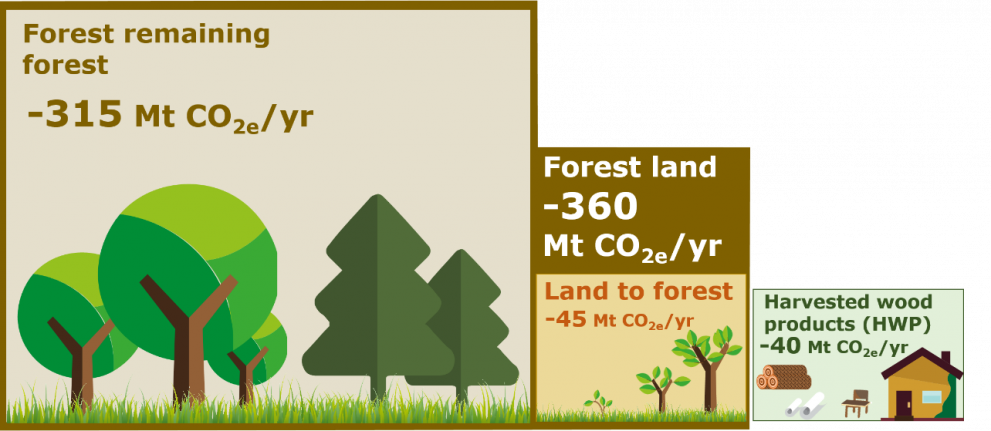
A new brief prepared by the JRC for the European Commission’s Knowledge Centre for Bioeconomy (KCB) outlines the crucial role that the European forest-based bioeconomy needs to play in order to achieve climate neutrality by 2050, and explores trade-offs and synergies between storing carbon in forests or in wood products, including when replacing other materials.
Forests capture carbon dioxide (CO2) from the atmosphere. As trees grow, the sequestered carbon accumulates in the form of biomass. Part of that biomass is harvested and processed into products - harvested wood products (HWPs) – in which the carbon is ‘locked in’ until their end of life.
Every year, forests and HWPs together sequester the equivalent of about 400 Mt CO2. This is about 10% of total EU-27 greenhouse gas emissions (GHGs).

In some applications, wood products can replace materials such as cement and steel, the production of which is highly energy intensive. Such substitution also generates a climate mitigation benefit as it helps avoid the significant GHG emissions during the production of such materials. Wood may also be used to replace fossil-fuel energy.
These possibilities demonstrate the key role that the forest-based bioeconomy can play in climate change mitigation. However, trade-offs and synergies exist amongst them.
Trade-offs and synergies
For example, the easiest solution to increase carbon storage in forests would appear to be to reduce the amount of wood harvested. However, this would have negative socio-economic impacts in the forest sector and would likely slow down the forest growth with a likely consequent saturation of the forest sink (the amount of carbon accumulated every year) in the long term.
On the other hand, increasing the harvest would make more wood available for HWPs (which lock in carbon) and for material substitution. However, in the short to medium term, the potential additional benefits of HWPs and material substitution are unlikely to compensate for the reduction in the net forest sink associated with the increased harvest.
Need to grow more trees to offset declining carbon sink
Current and projected trends suggest a declining net forest sink, in the short term, driven by the large areas of EU forests progressively reaching harvest maturity. According to the KCB brief, the annual net increment in forest growth would have to rise substantially, through forest management practices and new forest area, in order to reverse this trend. Some of this additional growth could also increase the potential for storing carbon in HWPs and for material substitution. The climate benefits from the latter can be enhanced also by a shift towards wood products with longer service lives and substitution benefits, e.g. from paper to materials used for building construction.
System perspective needed to assess policy options
Policies designed to promote an effective and resilient contribution of the forest-based bioeconomy to climate change mitigation need to assess all options from a ‘system perspective’. Such assessment could identify specific opportunities for maximising the contribution of the forest-based bioeconomy to climate change mitigation. For example, where a future increase in the harvest cannot be avoided (e.g. because of age-related dynamics in managed forests or adaptation needs), then using this extra harvest for storing carbon in long-lived wood products and for material substitution would bring more climate benefits compared with a scenario in which the use of wood for products remains unchanged.
Many EU policy initiatives already address the function of EU forests in mitigating climate change and in providing other ecosystem services, such as the EU Biodiversity Strategy, the EU Bioeconomy Strategy, the EU Climate Action and the Land use and forestry regulation for 2021-2030, which is currently under review.
The Commission is working to develop coherent evidence-based policies that foster synergies and avoid trade-offs so that the forest-based bioeconomy can help mitigate climate change and promote biodiversity for the benefit of the environment, the economy and society.
Further information
- KCB Brief on the role of the forest- sector based bioeconomy in mitigating climate change through carbon storage and material substitution
- Knowledge Centre for Bioeconomy (KCB)
Related Content
Details
- Publication date
- 6 May 2021
